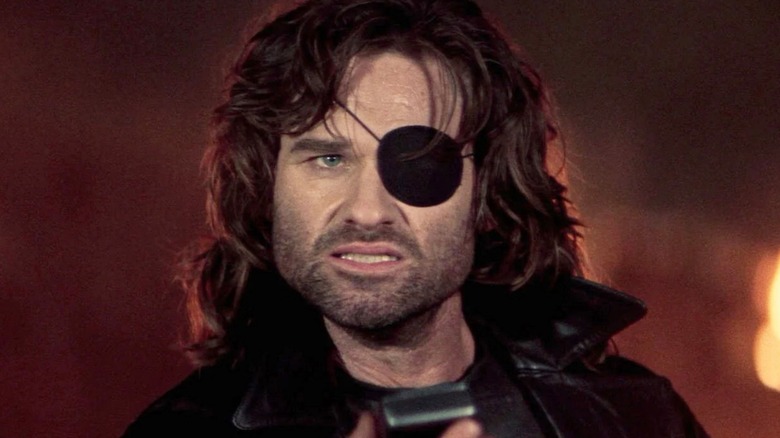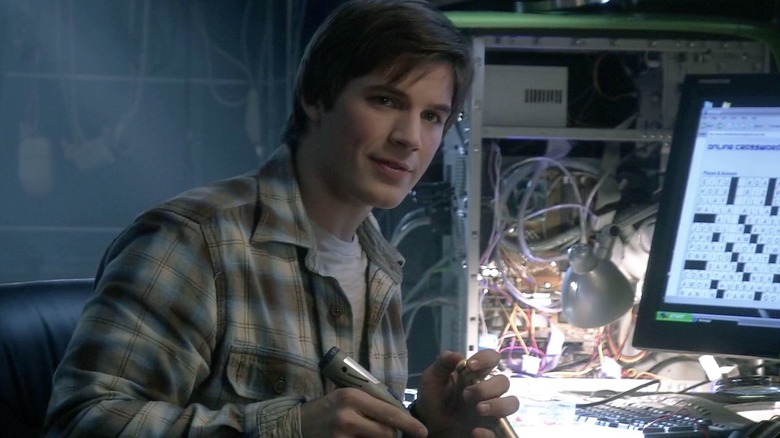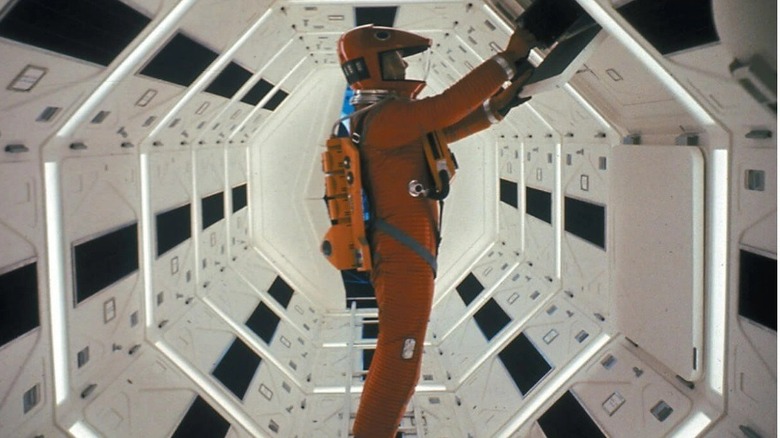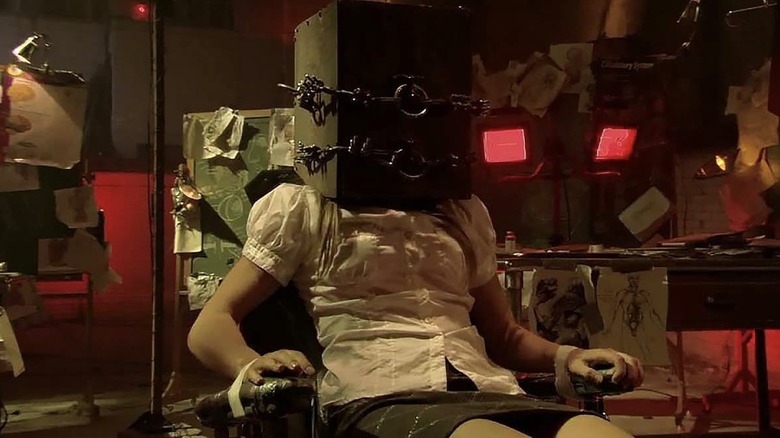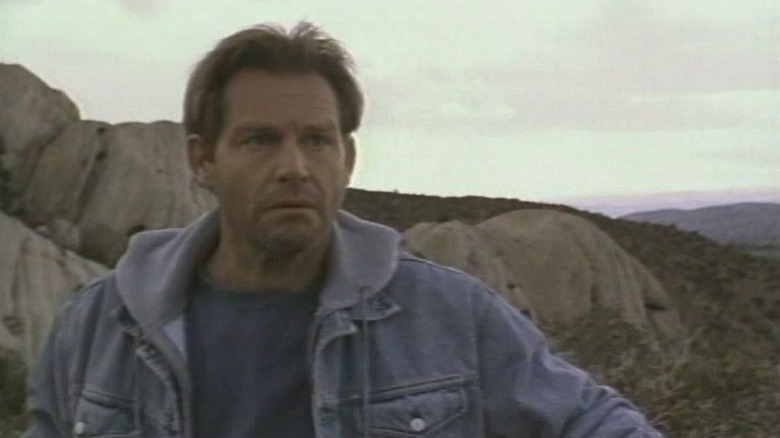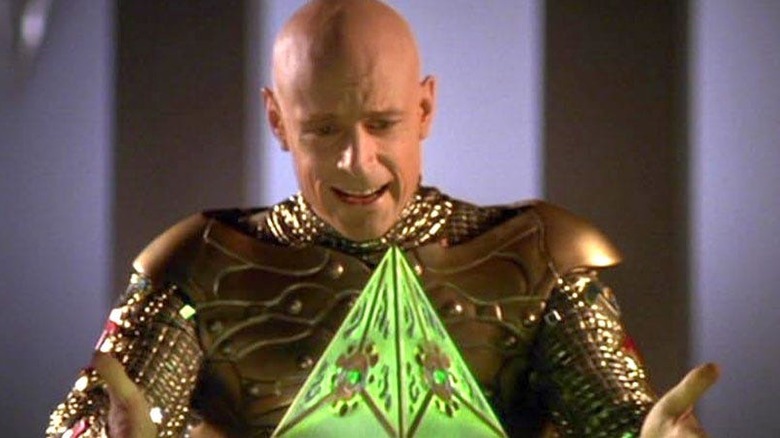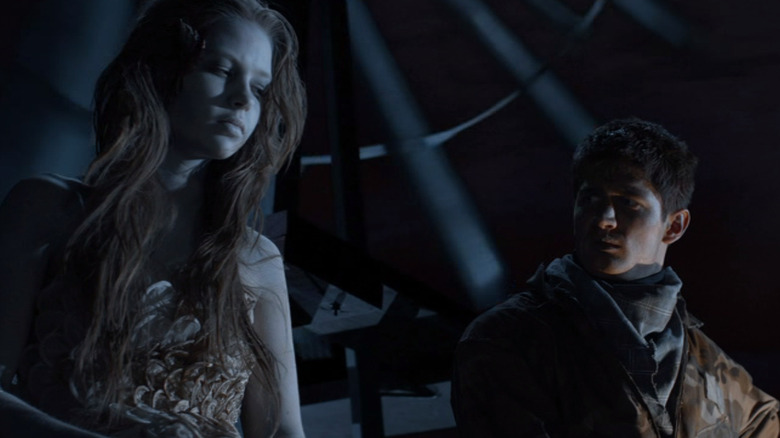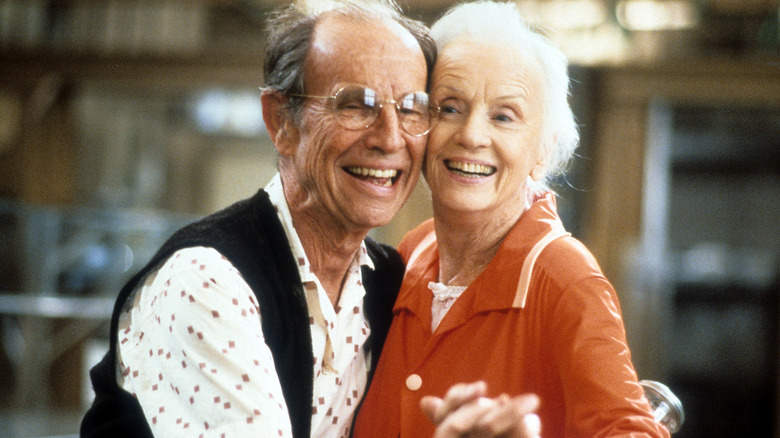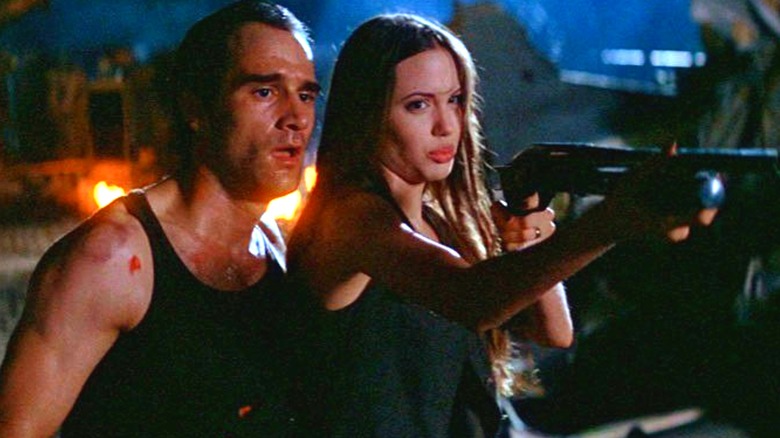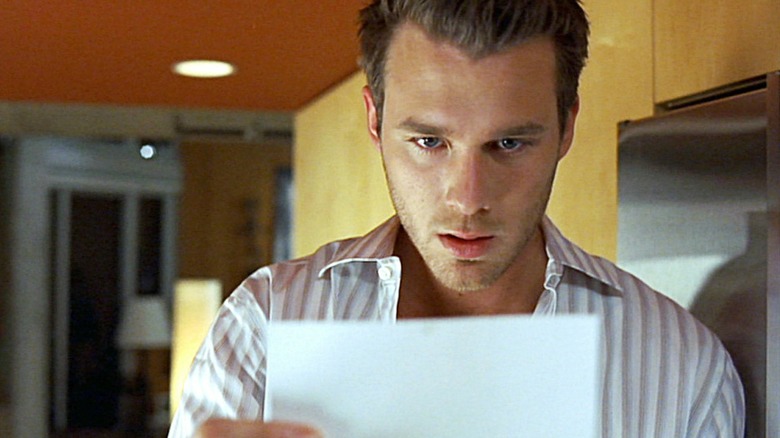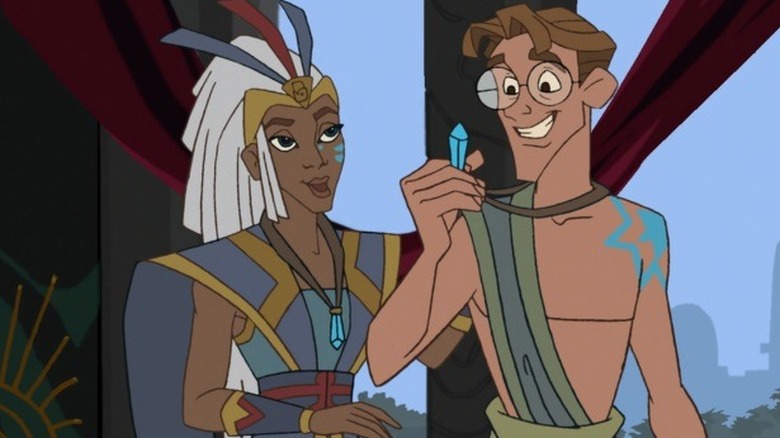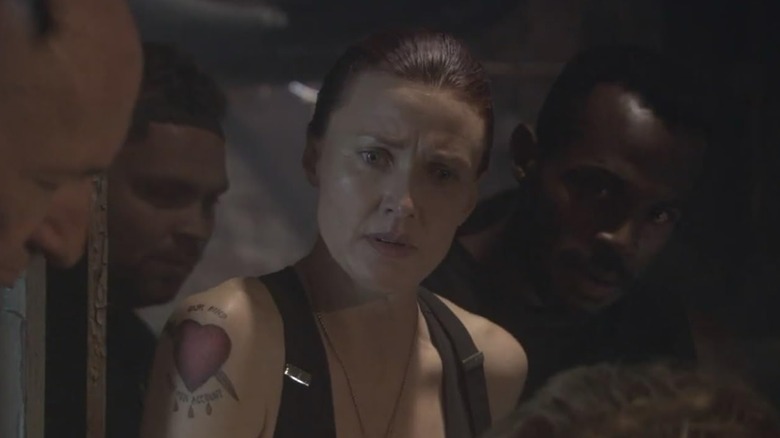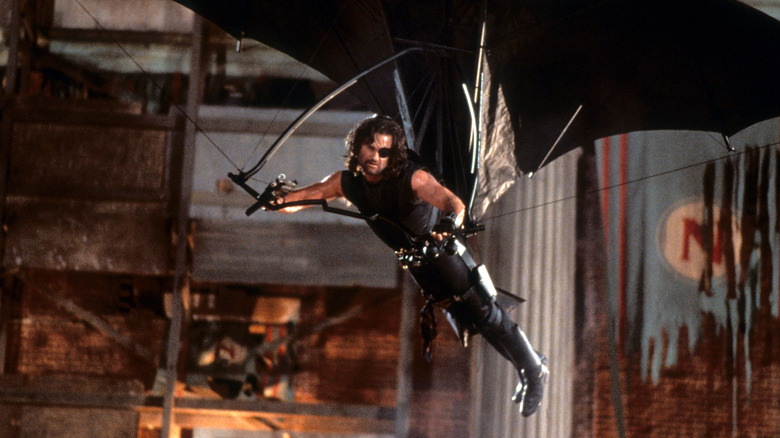Sci-Fi Movie Sequels You Had No Idea Existed
The sci-fi genre is no stranger to sequels. Just considering the likes of "Star Wars" and "Star Trek" alone, it's clear that sci-fi lends itself to follow-up movies that eventually turn into franchises. Very few hit sci-fi films are ever one and done, and the vast majority of them have at least one sequel produced in their wake. And even though a number of them have resulted in movie sequels so bad they actually ended a franchise, it is still more or less the rule that a sci-fi film that is even remotely successful will see at least another installment or two.
Even with this in mind, there are some sci-fi sequels that came and went without most people noticing — in some cases, even big fans of the original. Whether the sequel did pretty well at the time but was quickly forgotten, or the film was so bad that hardly anyone knew about it at all, there are various follow-ups to well-known sci-fi films that are often erroneously considered standalone products — and in most of these cases, they probably should have been.
WarGames: The Dead Code
While 1982's "Tron" was a much more on-the-nose look at what might happen if artificial intelligence got too powerful, "WarGames" — released the following year — opted to take that premise in a more believable direction. Instead of the hero literally entering the computer world and physically battling tangible manifestations of the digital evil as happens in Disney's sci-fi classic, "WarGames" sees teenaged hacker David (Matthew Broderick) sitting at a computer and playing a text-based war simulation against that movie's AI — or is it? — antagonist.
After spawning a novelization and several video games, the "WarGames" franchise went quiet for a couple decades. That is, until a direct-to-video sequel inexplicably showed up in 2008 by the name of "WarGames: The Dead Code." It retained the War Operation Plan Response (WOPR) program name from the original, as well having the main character be a young hacker, but the similarities largely end there. It never seems to quite settle on whether it is trying to be a remake of the original or an actual sequel, but the DVD packaging classifies it as the latter so that's what we're calling it. Either way, "The Dead Code" was dead on arrival, met with dreadful reviews, and failed to either be noticed by existing "WarGames" fans or create new ones.
2010: The Year We Make Contact
Not all forgotten sci-fi sequels are shuttled directly to home media. Sometimes they get theatrical releases, and might even receive a fair amount of attention when they do, but still ultimately fail to stay lodged in the public consciousness like their predecessors. Such is the case for "2010: The Year we Make Contact," the 1984 theatrical sequel to Stanley Kubrick's 1968 original, "2001: A Space Odyssey," which is generally considered to be one of the best sci-fi movies of all time.
Unlike "2001," which was developed simultaneously as a screenplay and novel by Kubrick and sci-fi writer Arthur C. Clarke, "2010" is a based on a book by Clarke alone — 1982's "2010: Odyssey Two." However, Kubrick wasn't interested in doing the film version of "2010," and Clarke gave his blessing but didn't help with the script as he had for "2001." This left writer-director Peter Hyams to go it alone and craft his own vision of Clarke's work, with critics largely positive on what Hyams accomplished. It also did decently at the box office, failing to topple its opening weekend competitor "Beverly Hills Cop" but besting sci-fi peers "Dune" and "Starman" in the ensuing weeks.
Over the years, however, "2010" failed to maintain the legacy of "2001" and, if it's mentioned alongside the original at all, it's never more than the briefest of footnotes. Subsequent generations of budding sci-fi film fans who go back to revisit the genre's history are often surprised to learn of the existence of "2010," if they even do.
The Cell 2
After making a name for himself with his visually arresting commercials and music videos — and winning a Grammy for directing the video of R.E.M.'s "Losing My Religion" — Tarsem Singh (sometimes credited simply as Tarsem) eventually moved into the world of movie directing. His feature film directorial debut was 2000's "The Cell," which was a perfect showcase for Tarsem's unique artistic vision, as large stretches of it took place inside a virtual reality program that allowed users to enter other people's dreams.
"The Cell" was already classified as more of a cult classic than an outright hit, barely breaking the $100 million mark at the worldwide box office on the back of a $33 million budget. Reviews were also mixed, with universal praise going to the visuals of the dream sequences but less so to the parts of the movie that took place in the real world. None of that seems to scream for a movie that needed — or even deserved — a sequel, but one was released nine years later anyway.
"The Cell 2" — which Tarsem had zero involvement in — often feels more like a rejected script for a sci-fi-tinged "Saw" sequel than the follow-up to "The Cell," but it at least loosely resembles its namesake by having a psychic enter the mind of the movie's killer in an effort to stop him. Called one of the worst movies of 2009, "The Cell 2" came and went with little fanfare.
It Came From Outer Space II
Sometimes it takes movie sequels decades to get off the ground. In the case of "It Came From Outer Space," there was an astounding 43-year gap between the original pioneering sci-fi film and its 1996 made-for-TV sequel. A popular misconception is that the original movie was based on an existing book by sci-fi author Ray Bradbury, when in fact it was a story he wrote specifically to be made into a film.
While technically a remake, the 1996 movie was titled as a sequel — perhaps owing to the lack of faith the powers-that-be had in how effectively it would pay homage to the original, which at that point had become a certified classic. Both movies are about a small town that has found itself the landing site for an alien spacecraft, and the effects that the new visitors seem to be having on the area and its residents. But while the first movie was a landmark in moviemaking for its day — particularly in its early use of 3D — "It Came From Outer Space II" looked very much like a cheaply-made mid-'90s TV movie. Aside from a small VHS print run, it has otherwise all but dropped off the face of the Earth.
Lawnmower Man 2: Beyond Cyberspace
Though marketed as a Stephen King adaptation, the 1992 sci-fi thriller "The Lawnmower Man" shares very little with King's story of the same name. Adapting King's tale proved a tough nut to crack, so the title and some vague elements of the story were instead grafted onto an original screenplay called "Cyber God." The resulting movie was critically panned and is considered among the worst Stephen King movies. But it became a cult classic due in large part to its cutting-edge use of computer animation, telling the story of a gardener named Jobe Smith (Jeff Fahey) who eventually becomes a fully digital being that begins murdering people via cyberspace.
"The Lawnmower Man" would have likely been a forgotten sci-fi movie in and of itself, if it weren't for its visuals and the publicity it received when Stephen King brought a lawsuit against the film's producers for using the name of one of his works to help sell a seemingly unrelated product. So the fact that it has a forgotten sequel is probably not especially surprising.
Fahey didn't reprise his role as Jobe, with Matt Frewer taking over as the titular villain. True to its title, "Lawnmower Man 2: Beyond Cyberspace" sees Jobe's reach extending to more of the real world, with his appearance no longer being entirely digital. While likely done for budgetary reasons, that decision robbed the sequel of most of the charm of the original, and it was a massive box office flop.
S. Darko
"Donnie Darko" might not have initially made a huge splash at the box office — the fact that it was released just one month after the September 11th terrorist attacks and a plane crash heavily factored into its plot didn't help its chances — but it found a rabid fanbase on home video and through subsequent theatrical re-releases. The twisty tale of a high school kid who may or may not be able to control time — and may or may not see a mysterious, rabbit-masked figure named Frank — hit at just the right time for a generation of budding film nerds to latch onto and obsess over, not to mention helping to make stars of Gyllenhaal siblings Jake and Maggie.
The movie eventually got so popular, in fact, that a sequel was produced in 2009 without any involvement from original writer-director Richard Kelly. "S. Darko" — so named because it follows Donnie's younger sister Samantha (Daveigh Chase), who is now 18 years old and seems to have inherited her brother's abilities — was massacred by critics and completely rejected by fans, many of whom didn't even bother with it due to the lack of Kelly's involvement nor the return of any of the original cast. Kelly himself stated in 2017 that he hadn't seen "S. Darko" yet and had no plans to do so, while also reaffirming that the movie didn't have his blessing and that he had zero involvement in it.
Cocoon: The Return
If you had cable television in the latter half of the 1980s, you will no doubt remember that sci-fi dramedy "Cocoon" seemed to be on near-constant rotation. It makes sense, as the movie was as heartwarming as it was family-friendly. The story followed the residents of a retirement home who discover a way to stop aging — a nearby swimming pool that a group of aliens are using to recharge their own life force. Eventually, the retirees meet up with the aliens, who offer to take them back to their home planet with the promise of immortality.
"Cocoon" was a big hit as well as critically acclaimed, going on to win Oscars not only for visual effects but also for supporting actor Don Ameche. Three years later, "Cocoon: The Return" was released to theaters and saw the aliens from the first movie come back to Earth, with the humans they took back to their planet at the end of the first film in tow.
"Cocoon: The Return" saw neither the critical praise nor the box office success of the first movie, nor did it have the second life that the original did on television to help keep it ageless over time. Not that very many people are necessarily revisiting the original "Cocoon" these days, but the ones that do certainly aren't bothering to make it a double feature with its disappointing and unnecessary sequel.
Cyborg 2
Most people were first introduced to Angelina Jolie in the cult classic 1995 cyber-thriller "Hackers" — including her future husband, co-star Jonny Lee Miller — but playing high school hacker Acid Burn wasn't her big screen debut. Technically, that occurred via a small role in dad Jon Voight's 1982 comedy "Lookin' to Get Out," when Jolie was just seven years old. But she'd make a more official entry into Hollywood a little over a decade later, when she played the female lead in sci-fi actioner "Cyborg 2."
The fact that more people aren't aware of Jolie starring in an action flick alongside Elias Koteas, Jack Palance, and Billy Drago two years before "Hackers" just speaks to how little-known "Cyborg 2" is in the first place. The original movie was a scrappy 1989 vehicle for Jean-Claude Van Damme, playing a bodyguard named Gibson who has to protect a woman named Pearl against a mercenary group led by a villain named Fender — and, no, the ridiculous musical equipment-based names don't stop there.
"Cyborg" wasn't a monster hit, but it did well considering its modest budget and was deemed worthy of a theatrical sequel, with a third direct-to-video installment completing the "Cyborg" trilogy. Van Damme didn't return for either sequel, nor did Jolie come back for "Cyborg 3: The Recycler."
The Butterfly Effect 2
After spending a few years doing the rom-com rounds, Ashton Kutcher veered his film career into dramatic territory with 2004's "The Butterfly Effect." The sci-fi thriller saw Kutcher playing Evan Treborn, a college student who discovers that his frequent blackouts enable him to time travel within his own past. True to the title — named after the theory that an action as seemingly inconsequential as a butterfly flapping its wings can eventually snowball into something as significant as a tornado or hurricane — Evan finds himself trying to change various things about his past for noble reasons but having to deal with all the unintended negative consequences of those changes.
Critics were unimpressed by both the movie and Kutcher's dramatic acting chops, but "The Butterfly Effect" was nonetheless a hit at the box office. A sequel came out just two years later, a fairly short turnaround time considering the entirely new cast, but one that shows in the abysmal quality of "The Butterfly Effect 2." In fact, it didn't get a theatrical release in the United States, and couldn't even break $1 million at the worldwide box office in the territories it was released to.
It still somehow managed nearly $3 million in DVD sales despite very little marketing, which was enough to commission another entry, "The Butterfly Effect 3: Revelations," in 2009. But within a few years, the "Butterfly Effect" trilogy was all but forgotten, with fond memories of even the original being fairly few and far between.
Atlantis: Milo's Return
This one might not seem especially surprising given the prevalence of Disney direct-to-video sequels. But those are typically reserved for movies that did well initially — and "Atlantis: The Lost Empire" most definitely did not. While a worldwide box office tally of $186 million for a 2001 release might not seem like anything to be ashamed of, it's disappointing for a movie with a production budget of $120 million. When considering marketing costs and the like, "Atlantis" definitely lost a fair amount of money.
Disney had big plans for "Atlantis" as a franchise, including an animated series and ambitious attractions at Disneyland and Walt Disney World — all of which were cancelled in the wake of the movie underperforming. But the company tried to at least recoup some of the cash that had already been sunk into those projects by turning three episodes of the planned series into the direct-to-video film "Atlantis: Milo's Return" in 2003.
A straight-to-DVD follow-up to a movie that was already a flop, not released until two years after the fact, all but doomed "Milo's Return" to sink beneath the waves. Not to mention that it got lost in the shuffle during a particularly prolific decade for direct-to-video Disney follow-ups, which saw even legendary properties suffer the fate of spawning Disney movie sequels you never existed.
Starship Troopers 2: Hero of the Federation
"Starship Troopers" is one of those movies that a lot of people didn't really get when it was first released. It was directed by Paul Verhoeven and written by Edward Neumeier, who had previously teamed on "RoboCop," another movie that was initially misunderstood but was eventually re-evaluated when people began to take a closer look at the satirical subtext. Nevertheless, many people still took "Starship Troopers" at face value as a straight sci-fi action film and were therefore disappointed as a result. Yet as with "RoboCop," it was eventually viewed through the lens of being critical of its themes — fascism and the militarization of society — rather than celebrating them, and is now rightfully considered a cult classic.
Unfortunately, the sequel seemed to miss the memo, and instead decided to be a more straight-up action movie about soldiers fighting with giant alien bugs. The fact that Neumeier wrote "Starship Troopers 2: Hero of the Federation" makes one wonder if it was more Verhoeven's direction that steered the first movie into satirical territory, with Neumeier actually wanting to play it straight all along. But playing it straight didn't pan out, and "Starship Troopers 2" was blasted by critics. "Starship Troopers 3: Marauder" tried to bring back the satire, but the movie itself was still a shadow of its underrated original and the damage had already been done by the second film.
Escape from L.A.
In 1996, it was almost impossible not to know that "Escape from L.A." existed. The sequel to "Escape from New York," John Carpenter's cult classic 1981 original, had a huge marketing push: it was difficult to drive down a highway without seeing its billboards or watch TV without seeing its commercials. Indeed, it was fun to see Kurt Russell reprising his role as legendary sci-fi antihero Snake Plissken, especially considering that Russell isn't known to show up for sequels — something he still has only done a couple of times throughout his seven-decade career.
So why is it on a list of sci-fi sequels you never knew existed? Because "Escape from L.A" barely made an impact at the box office, and those that have since gone back through Carpenter's filmography likely skipped right over it — something that would be easy to do given that it rarely shows up on streaming. Carpenter himself has always been outspoken in his fond feelings for it, and there are definitely several noticeably worse movies of his when ranking every John Carpenter movie. But it just didn't connect with the zeitgeist and has never truly earned the same cult status as its predecessor. That being said, of all the movies on this list, "Escape from L.A." is the one that is least deserving of being forgotten.
